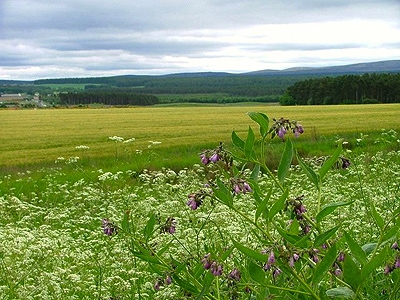Ecosystem Services: Looking Forward to Mid-Century

Policies need to balance various land uses to preserve valuable ecosystem services.
As population grows, society needs more — more energy, more food, more paper, more housing, more of nearly everything. Meeting those needs can lead to changes in how land is used.
Native grasslands, forests and wetlands may be converted into croplands, tree plantations, residential areas and commercial developments. Those conversions can, in turn, diminish the health of natural ecosystems and their ability to provide an array of valuable services, such as clean air and water, wildlife and opportunities for recreation, to name a few.
In two papers published in the Proceedings of the National Academy of Sciences, UC Santa Barbara’s Andrew Plantinga addresses how to strike a balance between providing for humanity’s growing needs and preserving the natural systems that make it possible to meet those needs.
In one paper, Plantinga, a professor at the Bren School of Environmental Science & Management, and colleagues model the future of land-use change in the United States under various scenarios and possible effects on the provision of some important ecosystem services. In a related publication, the researchers develop incentive structures to best encourage landowners to provide ecosystem services.
The work of the first paper explains a new land-use model for the contiguous U.S., which forecasts trends from 2001-2051 using two baseline scenarios and three policy alternatives designed to encourage forest cover and the preservation of natural landscapes as well as the reduction of urban expansion.“The 1990s Trend” baseline scenario assumes land-use trends will continue as they did during the 1990s, resulting in less cropland, pasture and rangeland and more forests and urbanization.
The “High Crop Demand” model accounts for significant growth in the demand for agricultural commodities as well as related pressures to expand agricultural lands. The researchers used these scenarios as alternative baselines against which they analyzed the effects of the three alternative land-use policies: forest incentives, natural habitats and urban containment.The first policy provides incentives for reduced deforestation and for afforestation — moving land into forest, whether by converting cropland to natural forest or by establishing commercial timber operations.
The second provides incentives for conserving natural habitats, and the third restricts urban land expansion.The key takeaway, Plantinga explained, is that there are tradeoffs for every policy regardless of which baseline scenario is applied. “Projected land-use changes by 2051 will likely enhance the provision of some ecosystem services and decrease the provision of others,” he said. In this application, ecosystem services are defined as the goods and services provided by nature that are of value to people.In the end, land use is not the most important component, according to Plantinga.
“The point is to identify which types of ecosystem services are provided as land use changes,” he concluded. “Food and carbon sequestrations are fine and may even rise under the various scenarios, but you may need strong incentives to limit declines in the provision of other ecosystem services.
”Incentive Structures for LandownersPlantinga collaborated with many of the same co-authors on another paper which identifies the best auction structure for securing ecosystem services, particularly those provided by private landowners. Building on established auction theory, the paper breaks new ground in structuring an auction that addresses three key challenges to inducing private landowners to provide optimal levels of ecosystem services.These include the spatial component of ecosystem services.
For example, adjoining parcels of land may be more valuable from the perspective of providing habitat than three fragmented parcels adding up to the same size. Additional challenges include asymmetric information, which refers to the fact that landowners know the opportunity cost of their land while the government agency does not, and the requirement to use voluntary incentives or what are often called payments for ecosystem services.
Because forests, clean rivers, climate regulation and other ecosystem services are freely available to everyone, landowners often receive nothing for actions they take on their own land that contribute to the pool of ecosystem services. Those services may be underprovided due to a lack of price incentives for private activities taken for the public good.
The researchers designed an auction that would elicit the optimal enrollment of lands —and the optimal provision of ecosystem services — in situations defined by asymmetric information and spatially dependent benefits.
Contact Info:
James Badham
james@bren.ucsb.edu
(805) 893-5049
Media Contact
All latest news from the category: Ecology, The Environment and Conservation
This complex theme deals primarily with interactions between organisms and the environmental factors that impact them, but to a greater extent between individual inanimate environmental factors.
innovations-report offers informative reports and articles on topics such as climate protection, landscape conservation, ecological systems, wildlife and nature parks and ecosystem efficiency and balance.
Newest articles

Long-sought structure of powerful anticancer natural product
…solved by integrated approach. A collaborative effort by the research groups of Professor Haruhiko Fuwa from Chuo University and Professor Masashi Tsuda from Kochi University has culminated in the structure…

Making a difference: Efficient water harvesting from air possible
Copolymer solution uses water-loving differential to induce desorption at lower temperatures. Harvesting water from the air and decreasing humidity are crucial to realizing a more comfortable life for humanity. Water-adsorption…

In major materials breakthrough
UVA team solves a nearly 200-year-old challenge in polymers. UVA researchers defy materials science rules with molecules that release stored length to decouple stiffness and stretchability. Researchers at the University…



